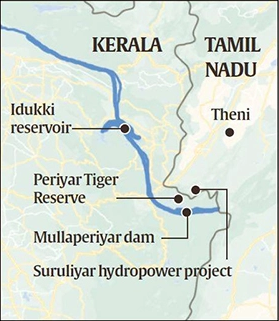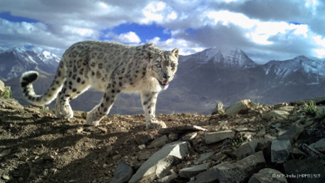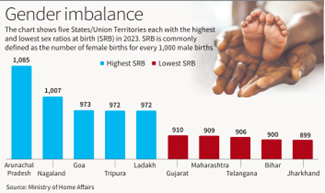Economy
PM GatiShakti – Offshore:
-
- PM GatiShakti – Offshore is a digital platform launched by the Logistics Division, Department for Promotion of Industry and Internal Trade (DPIIT), Ministry of Commerce and Industry, during the commemorative event celebrating four years of the PM GatiShakti National Master Plan (NMP) at New Delhi.
- It consolidates geospatial datasets from multiple ministries, enabling data-driven decision-making for projects like offshore wind farms, marine resource exploration, and coastal infrastructure.
- The platform aids in sustainable coastal growth, strengthens the Blue Economy, and supports India’s transition toward green energy.
- It provides critical insights by combining layers such as energy resources, environmental data, logistics infrastructure, and ocean hazard indicators, improving precision and transparency in planning.
- Stakeholders benefit from reduced regulatory risks, streamlined assessments, and efficient resource allocation for offshore projects.
(PIB)
History, Art and Culture
Mongolian Kanjur:
-
- An Indian delegation presented the sacred 108-volume Mongolian Kanjur to the Ketchenersky Khurul, a major Buddhist temple in Kalmykia, Russia.
- The event coincided with the first-ever exposition of Lord Buddha’s Holy Relics in Kalmykia from October 11–18, 2025, attracting thousands of devotees.
- The Mongolian Kanjur contains authoritative Buddha teachings, translated from Tibetan into classical Mongolian, and emphasizes India’s commitment to peace, compassion, and wisdom.
- ‘Kanjur’ means ‘Concise Orders’ or ‘Translated Words’ in Mongolian, referring to the direct teachings and discourses of Lord Buddha.
- The text is preserved in monasteries and revered through daily recitations and rituals.
- The events were organized by India’s Ministry of Culture with the International Buddhist Confederation, strengthening India-Russia cultural and spiritual diplomacy.
- India has played a key role in its preservation, reprinting the Kanjur under the National Mission for Manuscripts after obtaining microfilm copies during the 1950s.
(PIB)
Geography, Ecology & Environment
Mullaperiyar dam:
-
- It is a masonry gravity dam built across the Periyar River, located in Idukki district, Kerala, at the confluence of the Mullayar and Periyar rivers.
- Constructed between 1887 and 1895 by the British Corps of Royal Engineers, led by John Pennycuick, the dam is made with limestone and surkhi (burnt brick powder).
- The dam stands 53.6 meters high and 365.7 meters long, with a storage capacity of 443 million cubic meters.
- It was built primarily to divert the west-flowing Periyar River eastwards to the Vaigai River basin in Tamil Nadu for irrigation and power generation.
- While the dam is geographically in Kerala, it is operated and maintained by Tamil Nadu under a 999-year lease agreement made during British rule, which remains a matter of inter-state dispute, mainly regarding its safety.
- The dam’s reservoir is surrounded by the Periyar National Park, a major biodiversity hotspot.

(TH)
Snow leopard:
-
- It is a solitary, elusive big cat (Panthera uncia) native to the high mountains of Central and South Asia.
- IUCN Status: Vulnerable (2025)
- CITES: Appendix I
- India: Schedule I of the Wildlife Protection Act, 1972
- It inhabits cold, rugged terrain at elevations of 3,000–4,500 meters across 12 countries, including India, China, Nepal, Mongolia, and Russia.
- The global wild population is estimated at 3,920–6,390 individuals and is classified as Vulnerable due to threats like poaching and habitat loss.
- Snow leopards prefer rocky slopes, cliffs, and ravines, hunting herbivores such as blue sheep and ibex.
- Their thick fur, long tails, and large paws are adaptations for cold, dry mountain climates.
- They are important apex predators and indicators of ecosystem health, especially in the fragile Himalayan landscapes.
- Snow leopards are found in the Himalayan states of India, specifically in Ladakh, Jammu and Kashmir, Himachal Pradesh, Uttarakhand, Sikkim, and Arunachal Pradesh.
- Ladakh has the largest population, with an estimated 477 Hemis National Park is a famous spot for them.
- India’s first nationwide snow leopard population assessment (SPAI), conducted from 2019 to 2023, estimated a population of 718 snow leopards.
- It is a solitary, elusive big cat (Panthera uncia) native to the high mountains of Central and South Asia.

(TH)
Arctic seals, birds in new ‘red list’ of endangered species: IUCN:
-
- Arctic seals and birds are coming under increasing threat, mainly due to climate change and human activity.
- The International Union for Conservation of Nature (IUCN) said habitat loss driven by logging and agricultural expansion is a threat to birds.
- The IUCN also said it was changing the status of the hooded seal from vulnerable to endangered while bearded and harp seals are now classified as near threatened.
(TH)
Facts and Data
Society:
-
- India registered 52 crore births in 2023, around 2.32 lakh fewer than in 2022, the Vital Statistics of India based on the Civil Registration System (CRS) report for the year 2023 shows.
- The report, compiled by the Registrar-General of India (RGI), stated that 6 lakh deaths were registered in 2023, a marginal increase from 86.5 lakh deaths in 2022.
- Jharkhand recorded the lowest sex ratio at birth at 899, followed by Bihar at 900, Telangana at 906, Maharashtra at 909, Gujarat at 910, Haryana at 911 and Mizoram at 911.
- The highest sex ratio was reported by Arunachal Pradesh at 1,085, followed by Nagaland at 1,007, Goa at 973, Ladakh and Tripura at 972, and Kerala at 967.
- The share of institutional births in total registered births is 74.7 % in 2023.

(TH)
Miscellaneous
Nobel Prize in Economic Sciences 2025:
-
- It was awarded to Joel Mokyr, Philippe Aghion, and Peter Howitt for explaining innovation-driven economic growth.
- Mokyr used historical research to show that sustained economic growth requires not just technological advancements, but also a shift from knowing ‘how’ things work to knowing ‘why’ they work, triggered by the Scientific Revolution and Enlightenment.
- He emphasized the importance of society’s openness to change and acceptance of ‘creative destruction’ for economic progress.
- Aghion & Howitt developed a mathematical model demonstrating that technological innovation leads to turnover at the firm level but lays the foundation for stable national growth through creative destruction and interconnected markets.
- Their work has major policy implications for R&D subsidies and social welfare, highlighting the need for balance between innovation incentives and social safety nets.
(TH)
PRACTICE MCQ’S
Q1. Consider the following statements regarding the Mullaperiyar Dam:
1. The dam is located in Kerala but is operated and maintained by Tamil Nadu.
2. The Supreme Court has permitted Tamil Nadu to raise the water level while Kerala is citing seismic risks and environmental concerns.
Which of the statements given above is/are correct?
a) 1 only
b) 2 only
c) Both 1 and 2
d) Neither 1 nor 2
Answer: C
Explanation:
Statement 1 is correct because the Mullaperiyar Dam is located in Kerala but is operated and maintained by Tamil Nadu under a 999-year lease agreement signed in 1886 between the Maharaja of Travancore and the British government, which continues to be in effect post-independence.
Statement 2 is also correct as the Supreme Court, in its 2014 verdict, permitted Tamil Nadu to raise the water level to 142 feet after reviewing safety assessments, while Kerala, citing seismic risks and environmental threats to the surrounding Periyar National Park, has consistently opposed higher levels and proposed building a new dam for safety.
Q2. Consider the following statements regarding the Mongolian Kanjur:
1. It comprised of 108 volumes and contains the translated discourses of Lord Buddha from Tibetan into classical Mongolian.
2. In India its texts are being reprinted under the National Mission for Manuscripts using microfilm copies preserved from the 1950s.
Which of the statements given above is/are correct?
a) 1 only
b) 2 only
c) Both 1 and 2
d) Neither 1 nor 2
Answer: C
Explanation:
Statement 1 is correct because the Mongolian Kanjur is a 108-volume canonical text of Buddhism, containing the direct teachings (sutras) of Lord Buddha, translated from Tibetan into classical Mongolian, and is regarded as the most authoritative religious scripture in Mongolia.
Statement 2 is correct as India, through the Ministry of Culture and the International Buddhist Confederation, presented the reprinted set of the Mongolian Kanjur to Buddhist institutions in Kalmykia, Russia. The reprinting was carried out under the National Mission for Manuscripts (NMM) after obtaining microfilm copies of the original manuscripts in the 1950s, highlighting India’s role in preserving and sharing Buddhist heritage.
Q3. Which of the following statements about the snow leopard are correct?
1. The snow leopard is found in high-altitude areas across 12 countries, including India and China.
2. It is classified as Vulnerable on the IUCN Red List.
3. Snow leopards are found in only four states in India.
4. The species is exempt from protection under India’s Wildlife (Protection) Act, 1972.
Select the correct answer using the codes given below:
a) 1 and 2 only
b) 2, 3 and 4 only
c) 1, 2 and 4 only
d) 1, 2, 3 and 4
Answer: A
Explanation:
Statements 1 and 2 are correct: Snow leopards inhabit high-altitude mountains of 12 countries (Afghanistan, Bhutan, China, India, Kazakhstan, Kyrgyzstan, Mongolia, Nepal, Pakistan, Russia, Tajikistan, and Uzbekistan) are listed as Vulnerable on the IUCN Red List.
Statements 3 and 4 are incorrect: Snow leopards are found in states of Uttarakhand, J & K, Himachal Pradesh, Sikkim and Arunachal Pradesh as well as UT of Ladakh, and they receive the highest protection under India’s Wildlife (Protection) Act, 1972.
Q4. Consider the following statements about the PM Gati Shakti National Master Plan:
1. It is a digital platform developed by BISAG-N that integrates infrastructure data from various ministries.
2. The scheme aims to reduce India’s logistics costs.
3. It subsumes major initiatives like Bharatmala, Sagarmala, and UDAN under a single planning framework.
4. The platform uses ISRO satellite imagery and GIS tools to enable real-time monitoring and gap analysis.
Select the correct answer using the codes given below:
a) 1 and 2 only
b) 2, 3 and 4 only
c) 1, 2 and 4 only
d) 1, 2, 3 and 4
Answer: D
Explanation:
All four statements are correct: PM Gati Shakti is a GIS-based digital platform developed by BISAG-N that integrates 16 ministries for synchronized infrastructure planning. It aims to cut logistics costs from ~14% to ~8% of GDP. It brings together flagship schemes like Bharatmala, Sagarmala, and UDAN. The platform uses ISRO satellite data and GIS for spatial planning, real-time monitoring, and identifying infrastructure gaps.
Q5. Consider the following statements regarding the 2025 Nobel Prize in Economic Sciences:
1. Joel Mokyr was awarded for identifying the historical and cultural prerequisites for sustained economic growth through technological progress.
2. Philippe Aghion and Peter Howitt were jointly awarded for developing the theory of sustained growth through ‘creative destruction’.
Which of the statements given above is/are correct?
a) 1 only
b) 2 only
c) Both 1 and 2
d) Neither 1 nor 2
Answer: C
Explanation:
Statement 1 is correct because Joel Mokyr was awarded half the 2025 Nobel Prize in Economic Sciences for identifying the historical and cultural prerequisites—such as propositional knowledge from the Scientific Revolution and societal openness to change—that enable sustained economic growth through technological progress.
Statement 2 is correct as Philippe Aghion and Peter Howitt jointly received the other half for developing the theory of sustained growth through ‘creative destruction’, using a mathematical model that links firm-level innovation, market competition, and macroeconomic stability.
Spread the Word
